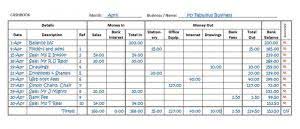Content
Deferred revenue, also known asunearned revenue, refers to advance payments a company receives for products or services that are to be delivered or performed in the future. The company that receives the prepayment records the amount as deferred revenue, a liability, on itsbalance sheet. The accounting concept known as revenue recognition states that revenue is recognized when earned. In the landscaper example, when the $200 payment was received, no landscaping services had been performed. As the landscaper performs weekly maintenance services, $50 will move from the balance sheet as deferred revenue to the income statement as earned revenue. Before MicroTrain prepares its financial statements, it must make an adjusting entry to transfer the amount of the services performed by the company from a liability account to a revenue account. The accrual journal entry to record the sale involves a debit to the accounts receivable account and a credit to sales revenue; if the sale is for cash, debit cash instead.
Since prepaid revenue is a liability for the business, its initial entry is a credit to an unearned revenue account and a debit to the cash account. You will notice that the transactions from January 3, January 9, January 12, and January 14 are listed already in this T-account.
Boundless Accounting
The web development firm would then recognize $7,500 in revenue for that period. Revenue should not be recognized until the seller has substantially accomplished what it must do pursuant to the terms of the arrangement, which usually occurs upon delivery or performance of the services. An increasing trend toward sales to a different class of customer, such as a reseller distribution channel that has a lower gross profit margin than existing sales that are principally made to end users. Also, increasing service revenue that has a higher profit margin than product sales. Accounting for revenues and costs of revenues requires estimates in many cases; those estimates sometimes change. When it comes to owning a successful small business, cash will always be king.
The staff presumes that reliable estimates cannot be made if the customer’s termination or cancellation and refund privileges exceed one year. Upon inception of the license term, revenue should be recognized in a manner consistent with the nature of the transaction and the earnings process. The staff believes management and auditors are uniquely positioned to evaluate the facts and arrive at a reasoned conclusion. The staff will not object to a determination that is well reasoned on the basis of this guidance. For example, a company may not use written contracts but instead may rely on binding purchase orders from third parties or on-line authorizations that include the terms of the sale and that are binding on the customer.
What Kind Of Account Is Deferred Revenue?
On January 23, 2019, received cash payment in full from the customer on the January 10 transaction. On January 5, 2019, purchases equipment on account for $3,500, payment due within the month.
- The carrying value of the bond decreases $400 each period until it reaches its face value of $100,000 at the end of period five.
- Learn more about accrued revenue, accrual accounting principles, and how recording accrual revenue properly can be an asset to your SaaS business.
- This is posted to the Cash T-account on the credit side beneath the January 14 transaction.
- Having a debit balance in the Cash account is the normal balance for that account.
- Stripe, Paypal, Braintree, Checkout.com, GoCardless, and 27 other payment gateways.
In other words, the payments collected from the customer would remain in deferred revenue until the customer has received in full what was due according to the contract. Unearned revenue is capital received for services not yet rendered. It assumes a variety of forms, from rent paid in advance to contracts made before the delivery of services. For instance, assume your company rents office space and pays its landlord $50,000 in December for rent covering the period of January through May.
When Do You Record Unearned Revenue?
To overcome these shortcomings, FASB and IFRS joined hands to establish a new revenue recognition standard, called the ASC 606 Revenue from Contracts with Customers. Before we dive into the details, here are some key concepts and metrics of SaaS revenue recognition. Appendix A to IAS 18 provides illustrative examples of how the above principles apply to certain transactions. Paying for a magazine subscription / streaming service for the full year rather than paying by the month.
- The installment sales method recognizes income after a sale or delivery is made; the revenue recognized is a proportion or the product of the percentage of revenue earned and cash collected.
- The company can decide to write-off a bad debt when the payment is deemed uncollectible.
- An annual subscription for software licenses is an unearned revenue example.
- Sales of services rendered, recognized when services are completed and billed.
- If there was a debit of $5,000 and a credit of $3,000 in the Cash account, we would find the difference between the two, which is $2,000 (5,000 – 3,000).
- As a result of this purchase accounting rule, the entity revalues its deferred revenue to $30.
Accrual accounting suits subscription businesses because accrual revenue, if recognized correctly, actually tracks the MRR. The adjusting entry for unearned revenue will depend upon the original journal entry, whether it was recorded using the liability method or income method. And so, unearned revenue should not be included as income yet; rather, it is recorded as a liability.
Best Practices In Revenue Recognition
Other names used for this liability include unearned income, prepaid revenue, deferred revenue and customers’ deposits. You report unearned revenue on your business’ balance sheet, a significant financial statement you can generate with accounting software. You record it under short-term liabilities (or long-term liabilities where applicable). Since it is a cash increase for your business, you will debit the cash entry and credit unearned revenue.
The above journal entry converts unearned revenue into earned revenue. Since the actual goods or services haven’t yet been provided, they are considered liabilities, according to Accountingverse. The credit and debit are the same amount, as is standard in double-entry bookkeeping. This is why unearned revenue is recorded as an equal decrease in unearned revenue and increase in revenue . Unearned revenue is promised service that has not been performed. Hence, such revenue which is technically not a revenue has to be reported.
Recognizing Unearned Revenue: What Is Unearned Revenue & How To Calculate It
The confusion is understandable though as when you earn service revenue, your total assets also increase. Service https://online-accounting.net/ revenue is an income statement account and as such, would typically appear in a business’s income statement.
As an example, assume that Wrightway Corporation issues $100,000, 10%, 5-year bonds on January 1, with interest payable on January 1. The amortization of bond premium by the effective-interest method is similar to the procedures described for bond discount. For the second interest period, bond interest expense will be $11,271 ($93,925 x 12%) and the discount amortization will be $1,271. To illustrate, assume that Wrightway Corporation issues $100,000 of 10%, 5-year bonds on January 1, 2004, with interest payable each January 1. Compute the bond interest paid by multiplying the face value of the bonds by the contractual interest rate. To completely comply with the matching principle, interest expense as a percentage of carrying value should not change over the life of the bonds. Liquidity ratios measure the short-term ability of a company to pay its maturing obligations and to meet unexpected needs for cash.
The current maturities of long-term debt should be reported as current liabilities if they are to be paid from current assets. Current maturities of long-term debt are frequently identified in the current liabilities portion of the balance sheet as long-term debt due within unearned revenues are received before goods are delivered or services are rendered. one year. Unearned revenues – Companies such as magazine publishers and airlines typically receive cash before goods are delivered or services are rendered. Notesdue for payment within one year of the balance sheet date are generally classified as current liabilities.
What Is A Sales Accrual Journal Entry?
The accounting principle regarding revenue recognition states that revenues are recognized when they are earned and realized or realizable . In order words, for sales where cash was not received, the seller should be confident that the buyer will pay according to the terms of the sale. The matching principle’s main goal is to match revenues and expenses in the correct accounting period. The principle allows a better evaluation of the income statement, which shows the revenues and expenses for an accounting period or how much was spent to earn the period’s revenue. By following the matching principle, businesses reduce confusion from a mismatch in timing between when costs are incurred and when revenue is recognized and realized. The accounting principles suggest that an income shall be recognized only when the same is earned. Revenue is said to be earned only when the performance obligation for the provision of goods or rendering of services is completed.
This is why it’s essential to be proactive in accounting for them properly. After the full value of the advance payment has been earned, the liability account must then be debited for the amount earned, crediting the revenue account via an adjusting entry. At that point, the unearned revenue amount of current liabilities would drop by $7,500, and the cash could then be listed as a current asset instead using an adjusting journal entry. As the amount received in advance is earned, the liability account should be debited for the amount earned and a revenue account should be credited.
You can see at the top is the name of the account “Cash,” as well as the assigned account number “101.” Remember, all asset accounts will start with the number 1. The date of each transaction related to this account is included, a possible description of the transaction, and a reference number if available. There are debit and credit columns, storing the financial figures for each transaction, and a balance column that keeps a running total of the balance in the account after every transaction. The customer does not pay immediately for the services but is expected to pay at a future date. The customer owes the money, which increases Accounts Receivable.
Hence, you record prepaid revenue as an equal decrease in unearned revenue and increase in revenue . Generally accepted accounting principles require certain accounting methods and conventions that encourage accounting conservatism. Accounting conservatism ensures the company is reporting the lowest possible profit. A company reporting revenue conservatively will only recognize earned revenue when it has completed certain tasks to have full claim to the money and once the likelihood of payment is certain. Unearned revenue is most common among companies selling subscription-based products or other services that require prepayments.





